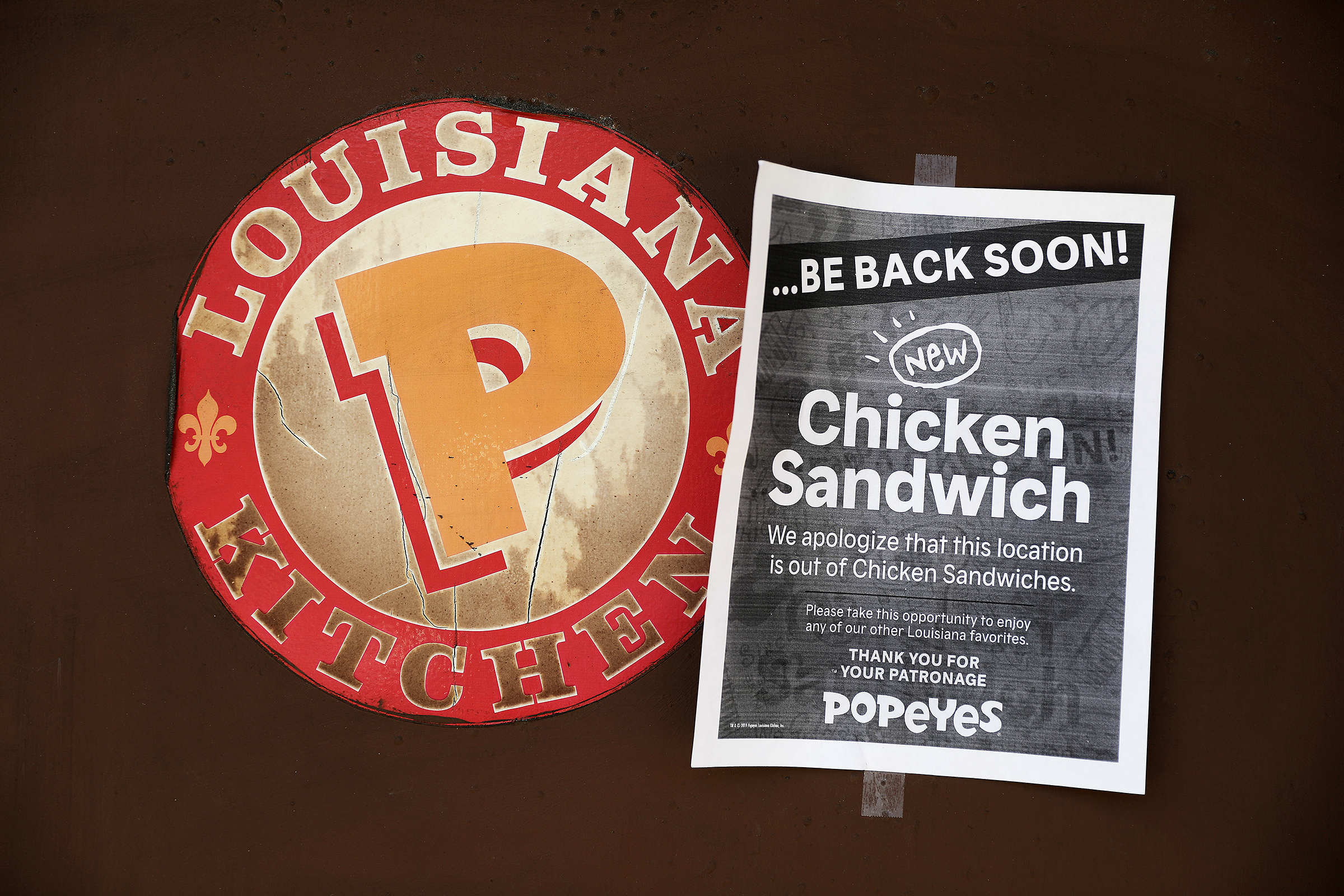
Like the discoveries of gravity and radiation, the Popeyes Chicken Sandwich phenomenon – which recently sparked huge crowds across the U.S., supply shortages, at least one case of customers demanding the sandwiches at gunpoint and up to $23 million in free publicity – happened mostly by mistake. Without a few errant tweets by Popeyes’ competitors, future American generations might not grow up hearing about the Great Chicken Wars of 2019. But despite the social-media-kindled fire and deep-fried fury, the sandwich that launched 1,000 memes was the result of years of calculated strategy and a creative process that sounds more collegiate than corporate.
The story begins in the late aughts when the company changed its official branding from Popeyes Chicken & Biscuits to Popeyes Louisiana Kitchen. This shift in identity not only aimed to attract a wider audience by emphasizing a localized, more wholesome-sounding operation, but also to expand the company’s culinary depth of field beyond its signature offerings. Chicken and biscuits are obviously delicious, but by drawing on its Cajun and Creole roots, Popeyes gave itself a way to stand out from countless other chicken chains. (Both Domino’s and Dunkin’ would later follow this tack, dropping “Pizza” and “Donuts” from their names, respectively.)
“There’s so much more we can do with the food and the menu,” Amy Alarcòn, the company’s vice president of culinary innovation, explained in a phone call in 2017. “Cajun gravy, tons of seafood promotions [like] spicy garlic and hushpuppy shrimp, Zatarain’s shrimp. Those types of things do tremendously well and it’s part of being on the Gulf Coast and coming from a culture that’s heavily dominated by seafood, crawfish boils, shrimp étouffée, the list goes on.”
In the world of fast food, it’s not easy to innovate in a way that can scale to thousands of locations consistently in order to scale to thousands of locations consistently. Concepts generally cannot cost too much, require new equipment, stray too far from a core set of ingredients or be too complicated to explain to consumers in 30-second ads between spots for home insurance and Chevy Silverados.
To invent within these tricky parameters, Popeyes created a product-invention process more personalized and elaborate than one might expect from a chain with 3,000 outposts around the world. A few times a year, the company invites about two dozen delegates from different corners of the company — from marketing to operations as well as its ecosystem of franchisees, suppliers and ad agencies — and sends them to a given U.S. city with a bustling food scene. In places like Portland, Ore., Charleston, S.C., and Seattle, the team seeks out inspiration by learning about local culinary history and, of course, by eating everything on offer from roadside stands and dives to fine-dining spots and Michelin-starred haunts. “We always joke, bring your big-boy pants,” said Alarcòn. “Bring the elastic waistband.”
Following this 72-hour, high-calorie rumspringa, the team spends the next few days brainstorming hundreds of potential Popeyes concepts by talking about evolving trends as well as their personal lives. Once the list is compiled, the group then undertakes the tedious work of stress-testing all the possibilities against their logistical realities, such as figuring out how the item would be produced, whether it would successfully scale on a global level and how it might be marketed. Finally, the company spends months developing and testing the chosen product internally before it arrives in stores.
In 2016, long before the new Popeyes Chicken Sandwich was a sketch on a drawing board, I joined one of their ideation sessions in New Orleans, the spiritual roost of the company, which is now headquartered in Miami. After a flurry of ghost tours, live jazz, remoulades, spiced pig ears and muffulettas, the group assembled at Mardi Gras World — the famous carnival-float emporium — to digest everything they consumed in the city’s oldest and newest institutions. But this was more than just a field trip. Each delegate was also tasked with sharing insights about food in terms of their lives and families. “I can pretty much guarantee that whatever your obsession is, it’s going to filter out into the larger audience because that’s our responsibility,” Alarcòn told the team before describing her obsession du jour: the comfort food of her childhood like fondue and casseroles.
Over king cake and coffee, each participant made a quick presentation, touching on themes and topics that would otherwise seem out of place at a fast-food ideation summit. A marketing manager discussed his pursuit of “cleaner eating” to help accommodate his partner’s autoimmune disease. A product developer told a story about bonding with his Brazilian mother-in-law by Skyping her in Rio and cooking together. A member of the social media team talked about a weekly ritual of getting sandwiches with his daughter at Jersey Mike’s subway chain. One franchisee had adapted his diet to work within the boundaries his family’s gluten-free regimen. Another chef talked about honoring his father by recreating a family Cajun-style barbecue recipe. Next, huge sheets of white paper were tacked to the walls and the ideas started to flow.
In the aftermath of the Popeyes sandwich fervor, what this intensive, intimate process reveals is how in the age of gimmicky, brightly colored, Instagram-friendly food items, there is also a literal and spiritual hunger for something relatable and familiar. After all, the Popeyes Chicken Sandwich, which will reportedly return to stores in the fall, is just a sandwich. Sometimes, that’s more than enough.
More Must-Reads from TIME
- Cybersecurity Experts Are Sounding the Alarm on DOGE
- Meet the 2025 Women of the Year
- The Harsh Truth About Disability Inclusion
- Why Do More Young Adults Have Cancer?
- Colman Domingo Leads With Radical Love
- How to Get Better at Doing Things Alone
- Michelle Zauner Stares Down the Darkness
Contact us at letters@time.com



